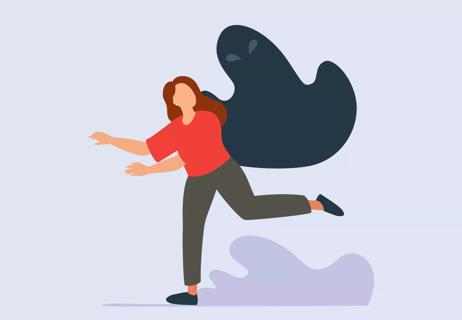Self-stimulating behaviors are often ways of self-regulating or coping with intense emotions

Have you ever been so bored in a meeting that you’ve started fidgeting with your pen? Or maybe you’ve been so distracted in class that you’ve doodled designs all over the margins of your notes? Maybe you’re a habitual throat-clearer, or you’re prone to literally jumping up and down with joy when you’re excited about something.
Advertisement
Cleveland Clinic is a non-profit academic medical center. Advertising on our site helps support our mission. We do not endorse non-Cleveland Clinic products or services. Policy
Whether you realize it or not, all of these habits could be considered self-stimulatory behaviors, also known as stims.
“Stimming, which is clinically referred to as ‘self-stimulatory behaviors,’ is identified by its repetitive movements and/or vocalizations,” explains behavior analyst Laura Howk, MS, BCBA. It’s often (though not always) associated with autism spectrum disorder (ASD) and other neurodevelopmental conditions.
Here’s what you need to know about stimming, including what it is, why people do it and when, if ever, it should be managed.
Stimming is when a person repeatedly makes the same movements or sounds.
“Stims are things you do without meaning to, and they usually serve some purpose, like helping you regulate your emotions,” Howk explains. “A lot of people stim, even if we don’t always hear it referred to that way.”
Maybe you tap your foot when you’re impatient or twiddle your thumbs when you’re bored. These kinds of repetitive behaviors are considered self-stimulatory behaviors, too, even if you don’t call them that or recognize them as such.
There are lots of reasons people may engage in these behaviors, including but not limited to:
Advertisement
Some people don’t know why they do it or may not even know the term “stimming” at all. Others, like young children and people who are nonverbal, may not have the words to talk about it.
“If you’re supporting someone who isn’t able to verbalize why they’re stimming, it can be helpful to take in data about the environment when their stimming behaviors are most likely to occur,” Howk says. “Ask yourself: Is it loud? Are there a lot of people around? Are they doing a task that is new or difficult?”
There are also times when it could be a sign of a medical issue. “In rarer instances, stimming can be a means of signaling or trying to relieve pain,” Howk states. In these situations, consult with a healthcare professional ASAP.
One thing is true across the board, Howk says: “Whether or not a person can verbalize the reason, this behavior serves a purpose for that person.”
There are countless examples of self-stimulatory behavior, but here are some of the more common forms, broken down by the senses and parts of the body they relate to:
It’s time to change the narrative around this question and move away from the idea of “controlling” or “treating” stimming behaviors.
In the past, healthcare providers focused on helping people minimize or hide stimming behavior, especially if it could be considered socially stigmatizing. For example, a child who flaps his arms when he’s excited might be encouraged to learn to stop for fear of bullying or teasing from his peers.
The intent might’ve been good, but the effect was often harmful. It fostered negative stigmas about stimming, making people feel frustrated. And for people who use stimming as a strategy for emotional regulation, decreasing or stopping can even impact their overall functioning.
“In recent years, the field has shifted to a greater focus of acceptance and understanding of stimming for what it is — a form of adaptive behavior that is sometimes used as a tool,” Howk explains.
“Stimming is often harmless, just a different way of processing sensory information,” Howk says. “More often than not, management and intervention aren’t necessary.”
That said, there are situations where stimming can become harmful or dangerous. But how can you tell if it rises to the level of requiring intervention? It depends.
Advertisement
“Sometimes, people who engage in extremely high rates of stimming struggle to attend to or focus on anything else,” she notes. It could also cause you to be unaware of dangerous situations around you (say, a busy street or heavy machinery) or to hurt yourself (like through head-hitting, skin-picking, biting, etc.).
If you’re the person doing the stimming, and you feel that it’s become a problem, then that’s answer enough. But what if you’re a parent of a child who’s stimming?
“We recommend using a general set of questions to determine if an intervention is needed,” Howk advises. Ask yourself:
If you’re supporting someone whose self-stimulatory behavior hurts them, causes them to be unaware of dangerous situations or puts them at risk, it’s best to speak with a professional who can help you figure out the best approach. This may include:
Here are some strategies you may encounter:
Advertisement
Advertisement
In rarer or more extreme cases, protective equipment is an option. “It’s used as a means of sensory extinction,” Howk says, “which means that it dulls the sensation while a person is learning a safer option.”
Remember: Learning from healthcare professionals isn’t a substitute for learning from people with autism.
“Many people within the autism community are passionate about stimming, and they emphasize that awareness and acceptance are key,” Howk says. “It’s crucial that we listen to people with autism on this topic and all others relating to them.”
To hear more about this topic, listen to the Health Essentials Podcast episode, “Autism Spectrum Disorder in Kids.” New episodes of the Health Essentials Podcast publish every Wednesday.
Learn more about our editorial process.
Advertisement

Fishing for compliments, provoking conflict and pouring on the melodrama are all ways of expressing an unmet need

By setting boundaries around how much you give, you can save your time and resources while also being a good person

Certain B vitamins, omega-3 fatty acids and a healthy diet can serve as complementary treatments for schizophrenia

Following your treatment plan, finding a community, staying active and maintaining a healthy diet can help manage this psychiatric condition

Whether it’s playing hooky or faking cancer, malingering behavior is always motivated by personal gain

Causes range from psychological conditions like PTSD to physical conditions like fibromyalgia

Always putting others’ happiness before your own can build resentment over time

Emotional changes, isolation and unusual behavior could signal the onset of the condition

The ‘sunshine vitamin’ is found naturally in some fish and is added to other foods

Autism and ADHD often go hand in hand, giving rise to the term AuDHD

The Yuzpe regimen is less effective than other forms of emergency contraceptives, and it’s associated with more side effects